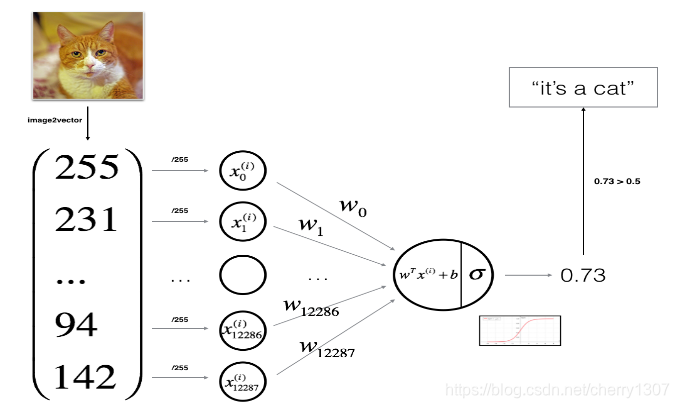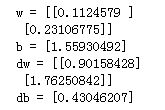吳恩達神經網路與深度學習——神經網路基礎習題2
阿新 • • 發佈:2018-12-19
神經網路思維的邏輯迴歸
1.初始化引數
2.計算代價函式及其導數
3.使用梯度下降
判斷影象上是否有貓
影象預處理
問題敘述
你得到了一個數據集(“data.h5”),包含:
-標記為cat ( y = 1 )或非cat ( y = 0 )的m個訓練集
-標記為cat或非cat的m個測試集
-影象大小為(num_px,num_px,3),其中3代表3個通道( RGB )。
你將建立一個簡單的影象識別演算法,可以正確地將圖片分類為貓或非貓。
包
numpy
h5py
matplotlib
PIL
scipy
# %load lr_utils.py import numpy as np import h5py def load_dataset(): train_dataset = h5py.File('datasets/train_catvnoncat.h5', "r") train_set_x_orig = np.array(train_dataset["train_set_x"][:]) # your train set features train_set_y_orig = np.array(train_dataset["train_set_y"][:]) # your train set labels test_dataset = h5py.File('datasets/test_catvnoncat.h5', "r") test_set_x_orig = np.array(test_dataset["test_set_x"][:]) # your test set features test_set_y_orig = np.array(test_dataset["test_set_y"][:]) # your test set labels classes = np.array(test_dataset["list_classes"][:]) # the list of classes train_set_y_orig = train_set_y_orig.reshape((1, train_set_y_orig.shape[0])) test_set_y_orig = test_set_y_orig.reshape((1, test_set_y_orig.shape[0])) return train_set_x_orig, train_set_y_orig, test_set_x_orig, test_set_y_orig, classes
視覺化
index = 25
example = train_set_x_orig[index]
plt.imshow(train_set_x_orig[index])
print ("y = " + str(train_set_y[:, index]) + ", it's a '" + classes[np.squeeze(train_set_y[:, index])].decode("utf-8") + "' picture.")

資料集尺寸
### START CODE HERE ### (≈ 3 lines of code) m_train = train_set_x_orig.shape[0] m_test = test_set_x_orig.shape[0] num_px = train_set_x_orig.shape[2] ### END CODE HERE ### print("m_train:"+str(m_train)) print("m_test:"+str(m_test)) print("num_px:"+str(num_px))

reshape
# Reshape the training and test examples ### START CODE HERE ### (≈ 2 lines of code) train_set_x_flatten = train_set_x_orig.reshape(train_set_x_orig.shape[0],-1).T test_set_x_flatten = test_set_x_orig.reshape(test_set_x_orig.shape[0],-1).T ### END CODE HERE ### print ("train_set_x_flatten shape: " + str(train_set_x_flatten.shape)) print ("train_set_y shape: " + str(train_set_y.shape)) print ("test_set_x_flatten shape: " + str(test_set_x_flatten.shape)) print ("test_set_y shape: " + str(test_set_y.shape)) print ("sanity check after reshaping: " + str(train_set_x_flatten[0:5,0]))

標準化資料集
train_set_x = train_set_x_flatten/255.
test_set_x = test_set_x_flatten/255.
總結
影象預處理步驟:
1.找出訓練集及測試集個數及影象尺寸( m _ train,m _ test,num _ px,...) )
2.resgape資料集,使每個影象成為一個大小為( num _ px * num _ px * 3,1 )的向量
3.“標準化”資料
學習演算法的一般結構


-初始化模型的引數
-通過最小化成本來學習模型的引數
-使用學習到的引數進行預測(在測試集上)
-分析結果並得出結論
構建我們演算法的各個部分
sigmoid函式
# GRADED FUNCTION: sigmoid
def sigmoid(z):
"""
Compute the sigmoid of z
Arguments:
z -- A scalar or numpy array of any size.
Return:
s -- sigmoid(z)
"""
### START CODE HERE ### (≈ 1 line of code)
s = 1 / ( 1 + np.exp(-z))
### END CODE HERE ###
return s

初始化引數
def initialize_with_zeros(dim):
"""
This function creates a vector of zeros of shape (dim, 1) for w and initializes b to 0.
Argument:
dim -- size of the w vector we want (or number of parameters in this case)
Returns:
w -- initialized vector of shape (dim, 1)
b -- initialized scalar (corresponds to the bias)
"""
### START CODE HERE ### (≈ 1 line of code)
w = np.zeros(shape=(dim,1),dtype=np.float32)
b = 0
### END CODE HERE ###
assert(w.shape == (dim, 1))
assert(isinstance(b, float) or isinstance(b, int))
return w, b
dim = 2
w, b = initialize_with_zeros(dim)
print ("w = " + str(w))
print ("b = " + str(b))

前向傳播和反向傳播
# GRADED FUNCTION: propagate
def propagate(w, b, X, Y):
"""
Implement the cost function and its gradient for the propagation explained above
Arguments:
w -- weights, a numpy array of size (num_px * num_px * 3, 1)
b -- bias, a scalar
X -- data of size (num_px * num_px * 3, number of examples)
Y -- true "label" vector (containing 0 if non-cat, 1 if cat) of size (1, number of examples)
Return:
cost -- negative log-likelihood cost for logistic regression
dw -- gradient of the loss with respect to w, thus same shape as w
db -- gradient of the loss with respect to b, thus same shape as b
Tips:
- Write your code step by step for the propagation. np.log(), np.dot()
"""
m = X.shape[1]
# FORWARD PROPAGATION (FROM X TO COST)
### START CODE HERE ### (≈ 2 lines of code)
yhat = sigmoid(np.dot(w.T,X)+b)
cost =-1/m*np.sum(Y*np.log(yhat)+(1-Y)*np.log(1-yhat),axis = 1)
### END CODE HERE ###
# BACKWARD PROPAGATION (TO FIND GRAD)
### START CODE HERE ### (≈ 2 lines of code)
dZ = yhat -Y
dw = 1/m*np.dot(X,dZ.T)
db = 1/m*np.sum(dZ,axis = 1 ,keepdims = True)
### END CODE HERE ###
assert(dw.shape == w.shape)
assert(db.dtype == float)
cost = np.squeeze(cost)
assert(cost.shape == ())
grads = {"dw": dw,
"db": db}
return grads, cost
w, b, X, Y = np.array([[1],[2]]), 2, np.array([[1,2],[3,4]]), np.array([[1,0]])
grads, cost = propagate(w, b, X, Y)
print ("dw = " + str(grads["dw"]))
print ("db = " + str(grads["db"]))
print ("cost = " + str(cost))

梯度下降法
# GRADED FUNCTION: optimize
def optimize(w, b, X, Y, num_iterations, learning_rate, print_cost = False):
"""
This function optimizes w and b by running a gradient descent algorithm
Arguments:
w -- weights, a numpy array of size (num_px * num_px * 3, 1)
b -- bias, a scalar
X -- data of shape (num_px * num_px * 3, number of examples)
Y -- true "label" vector (containing 0 if non-cat, 1 if cat), of shape (1, number of examples)
num_iterations -- number of iterations of the optimization loop
learning_rate -- learning rate of the gradient descent update rule
print_cost -- True to print the loss every 100 steps
Returns:
params -- dictionary containing the weights w and bias b
grads -- dictionary containing the gradients of the weights and bias with respect to the cost function
costs -- list of all the costs computed during the optimization, this will be used to plot the learning curve.
Tips:
You basically need to write down two steps and iterate through them:
1) Calculate the cost and the gradient for the current parameters. Use propagate().
2) Update the parameters using gradient descent rule for w and b.
"""
costs = []
for i in range(num_iterations):
# Cost and gradient calculation (≈ 1-4 lines of code)
### START CODE HERE ###
grads, cost = propagate(w=w, b=b, X=X, Y=Y)
### END CODE HERE ###
# Retrieve derivatives from grads
dw = grads["dw"]
db = grads["db"]
# update rule (≈ 2 lines of code)
### START CODE HERE ###
w = w - learning_rate*dw
b = b - learning_rate*db
### END CODE HERE ###
# Record the costs
if i % 100 == 0:
costs.append(cost)
# Print the cost every 100 training examples
if print_cost and i % 100 == 0:
print ("Cost after iteration %i: %f" %(i, cost))
params = {"w": w,
"b": b}
grads = {"dw": dw,
"db": db}
return params, grads, costs
params, grads, costs = optimize(w, b, X, Y, num_iterations= 100, learning_rate = 0.009, print_cost = False)
print ("w = " + str(params["w"]))
print ("b = " + str(params["b"]))
print ("dw = " + str(grads["dw"]))
print ("db = " + str(grads["db"]))

預測
# GRADED FUNCTION: predict
def predict(w, b, X):
'''
Predict whether the label is 0 or 1 using learned logistic regression parameters (w, b)
Arguments:
w -- weights, a numpy array of size (num_px * num_px * 3, 1)
b -- bias, a scalar
X -- data of size (num_px * num_px * 3, number of examples)
Returns:
Y_prediction -- a numpy array (vector) containing all predictions (0/1) for the examples in X
'''
m = X.shape[1]
Y_prediction = np.zeros((1,m))
w = w.reshape(X.shape[0], 1)
# Compute vector "A" predicting the probabilities of a cat being present in the picture
### START CODE HERE ### (≈ 1 line of code)
A = sigmoid(np.dot(w.T,X)+b)
### END CODE HERE ###
[print(x) for x in A]
for i in range(A.shape[1]):
# Convert probabilities A[0,i] to actual predictions p[0,i]
### START CODE HERE ### (≈ 4 lines of code)
if A[0, i] >= 0.5:
Y_prediction[0, i] = 1
else:
Y_prediction[0, i] = 0
### END CODE HERE ###
assert(Y_prediction.shape == (1, m))
return Y_prediction
print ("predictions = " + str(predict(w, b, X)))

將所有函式合併到模型中
# GRADED FUNCTION: model
def model(X_train, Y_train, X_test, Y_test, num_iterations = 2000, learning_rate = 0.5, print_cost = False):
"""
Builds the logistic regression model by calling the function you've implemented previously
Arguments:
X_train -- training set represented by a numpy array of shape (num_px * num_px * 3, m_train)
Y_train -- training labels represented by a numpy array (vector) of shape (1, m_train)
X_test -- test set represented by a numpy array of shape (num_px * num_px * 3, m_test)
Y_test -- test labels represented by a numpy array (vector) of shape (1, m_test)
num_iterations -- hyperparameter representing the number of iterations to optimize the parameters
learning_rate -- hyperparameter representing the learning rate used in the update rule of optimize()
print_cost -- Set to true to print the cost every 100 iterations
Returns:
d -- dictionary containing information about the model.
"""
### START CODE HERE ###
# initialize parameters with zeros (≈ 1 line of code)
w, b = initialize_with_zeros(X_train.shape[0])
# Gradient descent (≈ 1 line of code)
parameters, grads, costs = optimize(w, b, X_train, Y_train, num_iterations, learning_rate, print_cost)
# Retrieve parameters w and b from dictionary "parameters"
w = parameters["w"]
b = parameters["b"]
# Predict test/train set examples (≈ 2 lines of code)
Y_prediction_test = predict(w, b, X_test)
Y_prediction_train = predict(w, b, X_train)
### END CODE HERE ###
# Print train/test Errors
print("train accuracy: {} %".format(100 - np.mean(np.abs(Y_prediction_train - Y_train)) * 100))
print("test accuracy: {} %".format(100 - np.mean(np.abs(Y_prediction_test - Y_test)) * 100))
d = {"costs": costs,
"Y_prediction_test": Y_prediction_test,
"Y_prediction_train" : Y_prediction_train,
"w" : w,
"b" : b,
"learning_rate" : learning_rate,
"num_iterations": num_iterations}
return d
d = model(train_set_x, train_set_y, test_set_x, test_set_y, num_iterations = 2000, learning_rate = 0.005, print_cost = True)

例子
# Example of a picture that was wrongly classified.
index = 1
plt.imshow(test_set_x[:,index].reshape((num_px, num_px, 3)))
print ("y = " + str(test_set_y[0,index]) + ", you predicted that it is a \"" + classes[int(d["Y_prediction_test"][0,index])].decode("utf-8") + "\" picture.")

迭代次數對代價函式的影響
# Plot learning curve (with costs)
costs = np.squeeze(d['costs'])
plt.plot(costs)
plt.ylabel('cost')
plt.xlabel('iterations (per hundreds)')
plt.title("Learning rate =" + str(d["learning_rate"]))
plt.show()

測試自己的影象
## START CODE HERE ## (PUT YOUR IMAGE NAME)
my_image = "my_image.jpg" # change this to the name of your image file
## END CODE HERE ##
# We preprocess the image to fit your algorithm.
fname = "images/" + my_image
image = np.array(plt.imread(fname))
my_image = skimage.transform.resize(image, output_shape=(num_px,num_px)).reshape((1, num_px*num_px*3)).T
my_predicted_image = predict(d["w"], d["b"], my_image)
plt.imshow(image)
print("y = " + str(np.squeeze(my_predicted_image)) + ", your algorithm predicts a \"" + classes[int(np.squeeze(my_predicted_image)),].decode("utf-8") + "\" picture.")
